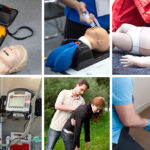Many of those who learn how to perform CPR, or cardiopulmonary resuscitation, may not know the long and curious history of this life-saving procedure. In its modern variation, CPR incorporates chest compressions and rescue breaths. This combination of techniques keeps the blood pumping throughout the body, allowing oxygen to reach the brain when someone is suffering from cardiac arrest.
CPR is a critically important life-saving procedure that anyone can learn. According to the Center for Disease Control, over 350,000 people undergo sudden cardiac arrest outside of a hospital. When these victims are far from medical attention, receiving CPR is a matter of life and death. Roughly 90 percent of cardiac arrest episodes are fatal if they occur outside of a hospital and the victim does not receive CPR.
If you’re interested in gaining the skills and confidence to save a life, or if your profession requires CPR certification, you can quickly and conveniently become professionally trained in CPR. In fact, many programs now offer CPR certification and recertification 100 percent online.
Here at the American CPR Care Association, we believe everyone should have access to high-quality and easy to understand CPR training. We offer nationally accepted certification for CPR/AED, First Aid, Bloodborne Pathogens, and Healthcare Provider courses. We also believe that education is the key to success, which is why we’re interested in the history of CPR as a life-saving procedure. In this blog, we look at the long history and development of CPR to help us better understand the evolution and importance of this life-saving procedure.
BELLOWS METHOD
In the 1530s, a Swiss physician named Paracelsus developed a resuscitation method that most people today would undoubtedly find unusual. With the Bellows method, someone would fit a fireplace bellows into the victim’s mouth and pump hot air directly into their lungs. However, this method proved to be less than effective since it did not extend the victim’s airway.
HALL AND SILVESTER METHODS
In the 1850s, two British physicians developed novel resuscitation techniques. Hall’s approach involved repositioning the victim from side to side and adding pressure to the thorax. Silvester, roughly around the same time, developed his own resuscitation technique known as the chest-pressure arm-lift method. For this, you raise the victim’s arm to relieve pressure and then lower it to exert pressure.
AMERICAN HEART ASSOCIATION
In 1924, six doctors met and formally created the American Heart Association (AHA). The AHA would go on to become one of the leading organizations in cardiovascular research and care and would standardize CPR techniques and research.
THE INVENTION OF MODERN CPR
Most people point to the 1960s as the time when our modern form of CPR was invented. In the 1960s, Dr. James Jude, Dr. Peter Safar, and Dr. James Elam first combined chest compressions with rescue breaths. Jude came to the realization that chest compressions could restart the heart’s pulse, while Safar and Elam incorporated mouth to mouth resuscitation. In 1963, the American Heart Association officially endorsed this method and gave us our modern-day CPR.
RESUSCI-ANNE
The 1960s also delivered another groundbreaking innovation in the history of CPR— “Resusci-Anne.” This lifelike manikin, also known as “Rescue Anne,” is used in CPR training courses to help individuals practice the steps of CPR. This manikin’s lifelike dimensions aid the real-life process and help individuals gain confidence in performing CPR on a real person.
DEFIBRILLATION PROGRAMS
In the 1990s, the United States began introducing Automated External Defibrillators (AEDs) into public buildings to respond to cardiac arrest episodes. This program also works to train individuals on how to safely and effectively use these devices. Currently, there are 3.2 million AEDs in public places. Despite this impressive number, there is still a major deficit in the number of AEDs needed in public spaces.
HANDS-ONLY CPR
One of the most recent developments in CPR is the hands-only approach. Cutting out the mouth-to-mouth resuscitation step, this technique only requires chest compressions and has proven to be effective. In the 2010s, this method is now widely taught and has gained popularity since many people may hesitate to perform rescue breathing on a complete stranger.
CPR AND CARDIAC ARREST STATISTICS
CPR is a critical, life-saving procedure to respond to those suffering from cardiac arrest, a heart attack, stroke, or even drowning. Below, we’ve included some common statistics to provide some context for the importance of learning and becoming certified in CPR:
- Each year, there are over 135 million cardiovascular deaths worldwide.
- More than 350,000 cardiac arrests occur outside of a hospital.
- Almost 50 percent of cardiac arrest victims survive if a bystander appropriately performs CPR.
- However, less than half of cardiac arrest victims receive bystander CPR.
- In the United States, over 10,000 cardiac arrest episodes occur in the workplace.
- Only half of the American workers can locate an AED in their workplace.
WHY SHOULD YOU LEARN CPR?
Anyone can, and should, learn CPR. Through a combination of chest compressions and rescue breaths, a properly trained and certified bystander can quickly take action and help someone suffering from a cardiac arrest episode, choking, gasping, and fasten recovery of drowned persons. Since the majority of cardiac arrest episodes occur far from a hospital or trained medical professionals, bystanders play an especially crucial role in responding to this type of emergency.
Learning CPR can also help you professionally. Many jobs, even those outside of the medical field, require CPR certification. You might be surprised to know that firefighters, police officers, electricians, and even flight attendants are trained in CPR and other life-saving procedures. Additionally, since so many cardiac arrests occur in the workplace, knowing this skill can make any employee more valuable.
CONCLUSION
Our modern version of CPR may have been introduced in the 1960s, but as you can tell, there was a lot of work and experimentation required to get us to where we are today. In many ways, this is the history of medicine as new techniques and innovations are built on the lessons of the past. Without the trials and lessons of the Bellows method, for example, we may never have developed CPR in its current form.
Today, it’s never been easier to learn CPR or recertify your skills and knowledge. Now that you can take CPR classes online, you can receive a professional and high-quality training program without ever leaving your home. You also don’t need to worry about scheduling classes, traffic, or fast-paced, confusing classes. With online CPR training, you’ll learn at a pace that fits your needs.
CPR is a valuable skill to lean and ensure you have the right knowledge and confidence to save a life in the event of an emergency. Because CPR is so essential, it’s important to make sure that you are keeping your skills current. Many people experience issues with the retention of even necessary CPR skills, such as chest compressions. Thus, everyone should ensure that they are not only receiving their CPR certification but that they are also renewing their skills at least a couple of times each year.
American CPR Care Association offers a 100 percent online CPR certification course in order to help you keep your skills fresh from the comfort of your own home and in your own schedule. For more information on the courses we offer, visit our website today or reach out to us at [email protected] or 1-888-808-9109.







